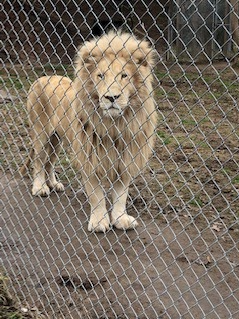Less than an hour away from Winthrop University in Rockwell, North Carolina lies a wildlife preserve called Tiger World. Many flock to see a Timbavati white lion named Michael as well as various tigers, ligers, leopards, cheetahs and other exotic animals. Tiger World is both a wildlife preserve and a private zoo. According to Tiger World’s website they are a nonprofit animal conservation and educational center. Tiger World is dedicated to the rescue, rehabilitation and preservation of exotic animals. Although Tiger World is well intentioned and treats all of their animals fairly, there remains controversy around whether wildlife preserves actually work towards conservation efforts.
According to the Director of Wildlife for Tiger World, Erin Carey, wildlife preserves – Tiger World in particular – do a lot to protect animals and educate the public. While Tiger World is both a zoo and a wildlife preserve it is able both preserve the animals housed there and educate the public about these animals.
“A wildlife preserve is an area of land that is protected and managed in order to preserve rare or endangered Flora and fauna. A zoo is an establishment which houses and maintains a collection of wild animals for study, conservation and to display to the public. So we are both, we are a safe place to preserve animals and educate the public about the plight of the natural environment,” Carey said.
While the animals that are housed at Tiger World are well cared for and numerous attempts at educating the public about these large, endangered species are made Tiger World, it is still a private zoo meaning there is less oversight than major zoos.
“Major zoos are regulated by the USDA and operate under the very strict codes of the AZA [the body that regulates zoos]. They have to demonstrate that they can meet the needs of these animals, that they are appropriately housed with regard to their physical health and psychological wellbeing. They have to agree to only breed their animals responsibly with regard to maintaining genetic diversity in the captive population…private preserves don’t have anything like this same level of regulation and oversight,” Janice L. Chism, a biology professor at Winthrop University, said.
So while Tiger World does have a breeding program it does not appear to have the same oversight and strict regulations that accredited zoos must follow. It is also important to note how animals end up in private zoos or wildlife preserves. The animals cannot be taken directly from their wild, native habitat – for example Africa or India – and brought into the United States for “protection.” Therefore, the animals in places such as Tiger World typically have already been in the United States living in captivity.
“[Tiger World] get most of their animals from the pet trade so almost all of these animals were bred in captivity or brought into the country illegally,” Chism said.
This was confirmed by the director of Wildlife at Tiger world, Erin Carey.
“80 percent of the animals [at Tiger World] are rescues: previous pets rehomed from zoos that have lost money or have been shut down and some are illegal confiscations,” Carey said.
Since the majority of animals in wildlife preserves such as Tiger World were already living in captivity for their who lives or the majority of their lives, many conservationists do not believe it is fair to say places such as Tiger World practices conservation efforts.
“These kinds of preserves like Tiger World really have almost no positive impact on conservation of endangered species…while probably a private zoo like Tiger World is a better place for a full grown tiger than somebody’s back yard …these preserves do not make any meaningful contribution to the conservation of wild endangered species of most animals- certainly not big cats or primates,” Chism said.
Tiger World and other private zoos cannot necessarily call themselves conservation areas. According to conservationists, a conservation area is a pace to protect native species in a particular area. Therefore, since tigers are not native to North Carolina, Tiger World is not a conservation area to them.
While many conservationists believe Tiger World does not do much for the conservation of wildlife they house there Tiger World does claim to have some conservation programs in place.
“Tiger World practices multiple conservation efforts…we educate the youth and public about species survival…through educational signs, guided tours…we are partners with the zoological Association of America and the species 360 program,” Carey said.
While there seems to always be controversy surrounding keeping animals in cages and holding them in captivity, it is important to note that most wildlife preserves do their best to care for the animals. It would not be fair for these animals to be set back into the wild after living in captivity for so long which is why zoos and wildlife preserves keep these animals under their care.
Tiger World wildlife specialists seem to have a disagreement with conservationists on how much wildlife preserves and private zoos practice conservation efforts. In conclusion, it seems to stand that as of right now most conservationists do not believe places like Tiger World do much for conservation at all.




